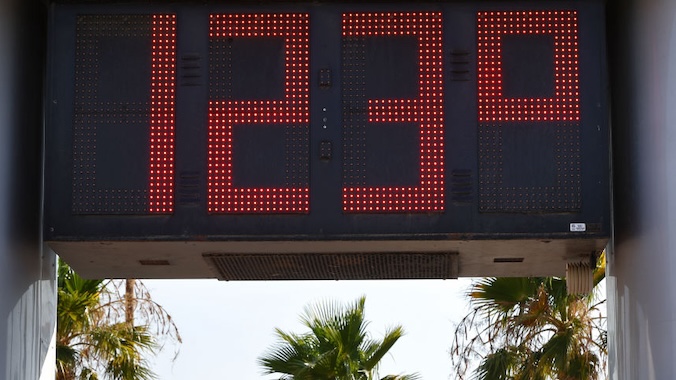Climate Science Disagreements At This Point Are Quibbles Over Circles of Hell
Photo by Mario Tama/Getty Images
The E.U.’s Copernicus Climate Change Service and the National Oceanic and Atmospheric Administration finally disagree about something. After more than a year straight of the two climate monitoring agencies marching in lockstep on the absurd string of record-warm month after record-warm month, Copernicus found that July was only the second-warmest such month in history, while NOAA says the streak continues and it was actually the hottest.
This is where climate science disagreements tend to fall these days: in the razor-thin barriers separating disparate circles of hell.
Copernicus found that July’s global average temperature was 0.68 degrees Celsius above the 1991 to 2020 average — or 0.04 degrees C below last July. NOAA, meanwhile, found the month was 1.21 degrees C above a different baseline, the full 20th century average temperature; that places it first on the list of July records, which means hottest on the list of all months ever recorded.
There isn’t really a fundamental difference here; the two estimates use slightly different sources for their global temperature record, but in the end the pattern is the same. This happens each January as well when NOAA and NASA offer their competing calculations for the previous year’s average temperature and where it ranks on the all-time list; sometimes they agree, sometimes they don’t, but they both are staring down a top-ten list made up entirely of the most recent ten years.
“Widespread, intense and extended heatwaves have hit every continent in the past year,” said World Meteorological Agency Secretary-General Celeste Saulo, in a press release on Tuesday. “This is becoming too hot to handle.” The WMO pointed out that the differences between Copernicus and NOAA estimates are so minor as to fall within the statistical margin of error; decimal places aside, everyone agrees it is hot out there.
NOAA now says that 2024 has more than a 77 percent chance of topping that hottest years list, beating out a 2023 that set the record by a mile. A month ago, that chance was 59.3 percent; after May it was below 50 percent. Even as the warming El Niño faded and a cooling La Niña meanders toward us, the mercury won’t stop ticking up.
In a sense, the minor disagreement between Copernicus and NOAA is a welcome change from decades past, when enough uncertainty either existed or could be plausibly theorized as to let bad actors continue to sow seeds of climate doubt. An anomalous satellite record, cherry-picked start or end years offering plateaued warming, and so on — only now, with every monitoring organization the planet showing the same dramatic upward shifts, no such denial (non-utter crackpot division) is really possible. Plenty of those bad actors have pivoted to other no less damaging campaigns, casting doubt on specific solutions or muddying the generally obvious economics of climate action, but the underlying science and its message — planet hot, getting hotter fast — is now beyond dispute. And so instead we get those hundredths of a degree of disagreement, quibbles over smoke detector placement long after the house burned to the ground.